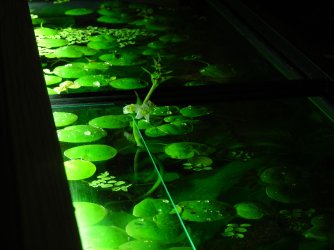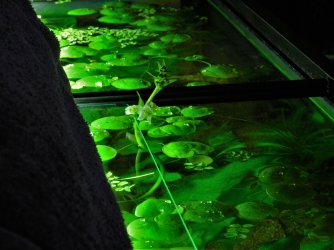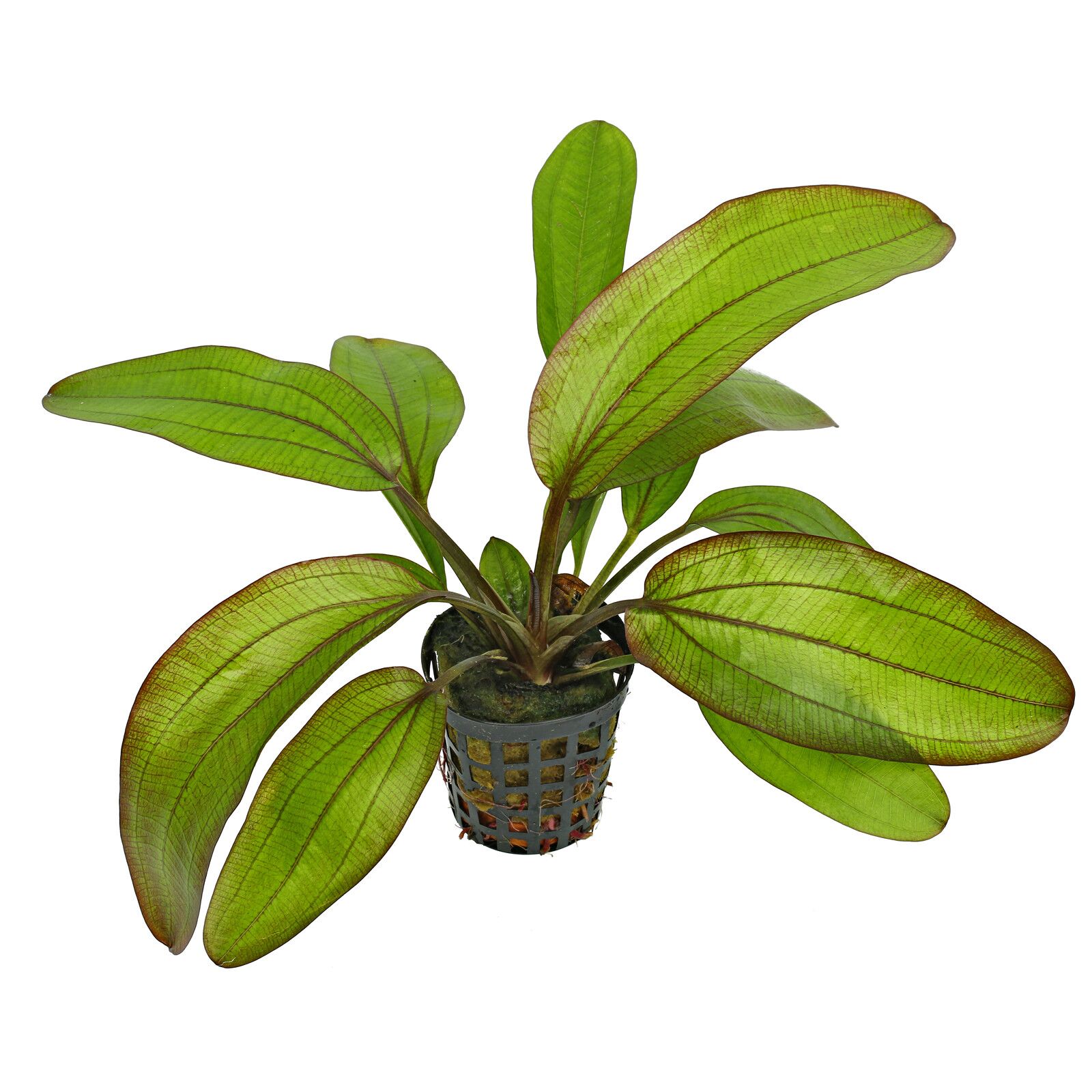I love it when members give me an opening like this to explain species...

I will just cut/paste from a profile of this species I wrote several years ago for another site (it's also a forum and we don't link to other forums). As will be explained, the "species"
Echinodorus bleherae is now synonymous with
E. grisebachii.
Echinodorus grisebachii
Family: Alismataceae
Synonyms:
Echinodorus amazonicus
Echinodorus amazonicus var.
parviflorus
Echinodorus amphibius
Echinodorus bleherae
Echinodorus eglandulosus
Echinodorus gracilis
Echinodorus grisebachii var.
minor
Echinodorus parviflorus
Common Name: Amazon Sword
Origin and Habitat: From Central America and Cuba down through South America to southern Brazil. Occurs in floodplains, palm swamps, rivers and creeks.
Lighting requirements: Moderate; grows well in diffused light. May manage in lower light.
Growth rate: Medium
Minimum Tank Suggestion: See description
Water parameters
Soft to slightly hard (hardness to 15 dGH, but if less than 4 dGH calcium supplementation will likely be necessary), acidic to slightly basic (pH 5 to 7.5) water, temperature 24-28C/75-82F. The “amazonicus” variety is less tolerant of hard water than the “bleherae” variety.
Description (for the “Bleherae” variety)
One of the most common aquarium species of sword plants and one of the most hardy and beautiful. Mid-green leaves numbering anywhere up to 30 arise from the crown and grow out in a fan formation to a length of up to 50 cm (20 inches) or more with the blade lanceolate and acute at both ends. Will often grow to the surface, so in larger tanks the plant will generally develop much larger in height if provided with adequate fertilization. A deep substrate is needed (minimum 3-4 inches); the root system is large, and will spread vertically and horizontally through the substrate far from the plant.
Echinodorus plants are heavy feeders, and in most aquaria will require regular fertilization with a comprehensive liquid fertilizer; adding substrate fertilization (root tabs) is extremely beneficial for stronger growth and larger development. If the leaves develop yellowing or transparent patches, it is a sign of insufficient nutrients. A balanced comprehensive fertilizer will ensure adequate nutrient supply in most cases, and comprehensive substrate tabs are highly recommended. In very soft water (less than 4 dGH) a calcium deficiency will often occur, resulting in excess iron deposits appearing as brown patches on the leaves; these will increase until the leaf and then the plant dies. The substrate tabs and liquid comprehensive fertilizer will resolve this problem.
E. grisebachii will produce an inflorescence (flower stalk), sometimes two or three at the same time and up to six or seven each year, which grow to the surface and above. Flowers will not appear unless the plant is grown emersed as a bog plant, but adventitious plants will develop from each node, two per node. This species does not send out substrate runners. The adventitious plants may be detached as new young plants once they develop sufficient roots and leaves, usually within 2-3 months.
As with the majority of species in this genus,
E. grisebachii is a bog (marsh) plant in nature, spending half the year emersed (during which it flowers) and half submersed. The “bleherae” variant prefers to grow submersed and therefore adapts well to fully-submersed conditions and is thus an excellent aquarium plant. Aquatic leaves will be quite different from emersed leaves, in shape, size and texture. Newly-purchased plants have often been propagated emersed by nurseries and when grown in the aquarium the developing submersed leaves will be different from those on the plant at purchase, and the older leaves will yellow and should then be removed.
This plant was originally described as a distinct species,
Echinodorus bleheri (Rataj, 1970), and the name was subsequently corrected by Dr. Rataj to
E. bleherae (the feminine gender); it was named in honour of Amanda Bleher who first exported it from Brazil over 40 years ago. As will be explained below, this is no longer deemed to be a distinct species botanically.
Discussion
Some of the most beautiful and useful plants for the tropical aquarium are found among the
Echinodorus, a genus distributed in the tropical and sub-tropical regions of the Americas from the lower United States down to Argentina; the two "African" species of Rataj are erroneous (Kasselmann, 2003; Lehtonen 2008).
Echinodorus derives from the Greek
echinos [hedgehog] and
doros [pipe or hose] referring to the spiny fruit. The English common name of "sword plant" comes from the general lanceolate shape of the leaf of most species and is generally used for all plants in this genus although other non-
Echinodorus plants may sometimes appear under the name "sword."
Larger-sized species have a rhizome, whereas smaller species are stoloniferous. All species are perennial or annual aquatic or marsh plants found in boggy flood areas or along the banks of stagnant or slow-flowing waters. Except for the very few species that are permanently submersed,
Echinodorus plants spend half the year emersed (when they flower) and the remainder submersed during the flood season. Leaves arise in a rosette and can be very variable not only between emersed and submersed forms but also when cultivated under different conditions. Correct identification often requires study of the flower. Inflorescences (flower stalks) are formed in all species; when grown permanently submersed in the aquarium most species will not flower but adventitious plants (daughter plants) will develop from the nodes on the inflorescence, two per node.
Confusion has existed for the past few decades over the number of species in the genus
Echinodorus, and many have been known under different names. In his earlier study of the genus, Rataj (1975) listed 47 species. A major revision by the botanists R.R. Haynes and L.B. Holm-Nielsen (1994) listed 26 species. In his 2004 revision, Rataj increased the number of species to 62. More recent work by Samuli Lehtonen—incorporating phylogenetic (DNA) analysis—proposed 28 valid species (Lehtonen, 2007). As of 2013, The Plant List and the World Checklist of Selected Plant Families (maintained by Kew) have 30 distinct species listed for
Echinodorus.
Haynes & Holm-Nielsen (1994) considered the species
E. bleherae, E. amazonicus and
E. parviflorus to be conspecific [the same species] with
E. grisebachii. Kasselmann (2002) suggested that the different habitus of the submersed plants between these three "species" is reason to retain the present names in the hobby. But Lehtonen's extensive phylogenetic analysis (2006) basically supports the findings of Haynes & Holm-Nielsen, with a few changes, and this classification is now accepted. The synonyms listed above are the former “species” that are now deemed to be within the one polymorphic species
E. grisebachii. Differences in appearance between these plants are apparent and seem dependent on the specific environment in the aquarium; this seems likely to also occur in nature, what can be termed transitional forms of the species. But the limited genetic variation within the complex is insufficient to establish reasonable groupings (Lehtonen & Falck, 2011).
This species epithet
grisebachii takes precedence over the others under the rules of the International Code of Botanical Nomenclature because it was the first name assigned to the species, and this was by the American botanist J.K. Small in 1909; the name honours the German botanist H.R.A. Grisebach (1814-1879).
References:
Haynes, R.R. and L.B. Holm-Nielsen (1994), "The Alismataceae,"
Flora Neotropica, Vol. 64, pp. 1-112.
Kasselmann, Christel (2002),
Aquarium Plants [English language edition, translated by Ulf Kotlenga].
Lehtonen, Samuli (2006), "Phylogenetics of
Echinodorus (Alismataceae) based on morphological data,"
Botanical Journal of the Linnean Society, 150, pp. 291-305.
Lehtonen, Samuli (2008), "An integrative approach to species delimitation in
Echinodorus (Alismataceae) and the description of two new species,"
Kew Bulletin Vol. 63, No. 4, pp. 525-563.
Lehtonen, Samuli and Daniel Falck (2011), “Watery Varieties: Aquarium Plant Diversity From Aesthetic, Commercial, and Systematic Perspectives,” in
Ornamental Plants: Types, Cultivation and Nutrition, ISBN 978-1-61761-736-2, online:
http://www.isentio.com/downloads/Lehtonen_from_Ornamental_FP.pdf
Lehtonen, Samuli and Leena Myllys (2008), "Cladistic analysis of
Echinodorus (Alismataceae): simultaneous analysis of molecular and morphological data,"
Cladistics, Vol. 24, No. 2 (April 2008), pp. 218-239.
The Plant List, 2013, Version 1.1, published on the Internet:
http://www.theplantlist.org/








 I will just cut/paste from a profile of this species I wrote several years ago for another site (it's also a forum and we don't link to other forums). As will be explained, the "species" Echinodorus bleherae is now synonymous with E. grisebachii.
I will just cut/paste from a profile of this species I wrote several years ago for another site (it's also a forum and we don't link to other forums). As will be explained, the "species" Echinodorus bleherae is now synonymous with E. grisebachii.
